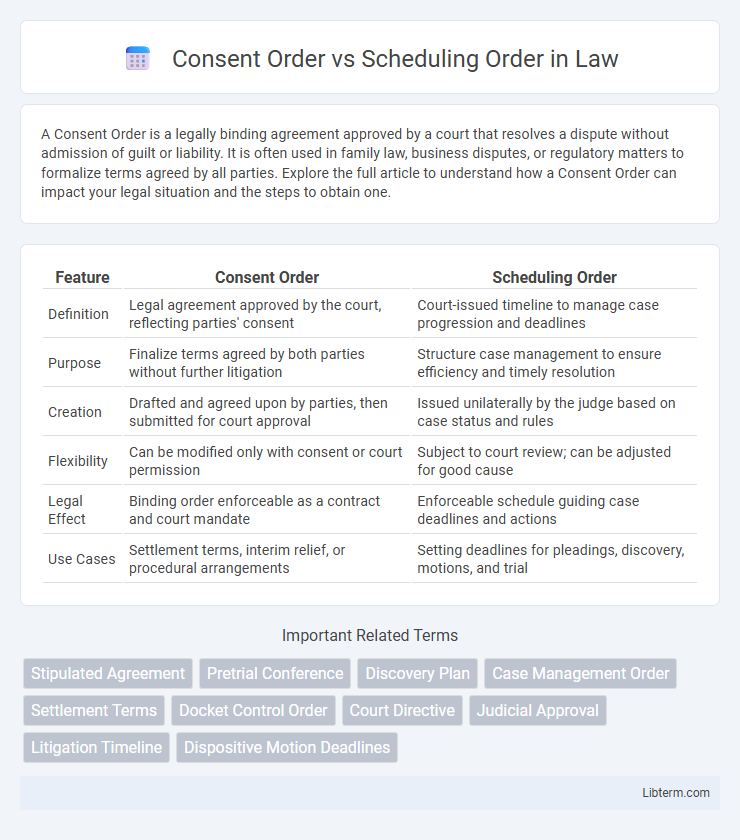A Consent Order is a legally binding agreement approved by a court that resolves a dispute without admission of guilt or liability. It is often used in family law, business disputes, or regulatory matters to formalize terms agreed by all parties. Explore the full article to understand how a Consent Order can impact your legal situation and the steps to obtain one.
Table of Comparison
| Feature | Consent Order | Scheduling Order |
|---|---|---|
| Definition | Legal agreement approved by the court, reflecting parties' consent | Court-issued timeline to manage case progression and deadlines |
| Purpose | Finalize terms agreed by both parties without further litigation | Structure case management to ensure efficiency and timely resolution |
| Creation | Drafted and agreed upon by parties, then submitted for court approval | Issued unilaterally by the judge based on case status and rules |
| Flexibility | Can be modified only with consent or court permission | Subject to court review; can be adjusted for good cause |
| Legal Effect | Binding order enforceable as a contract and court mandate | Enforceable schedule guiding case deadlines and actions |
| Use Cases | Settlement terms, interim relief, or procedural arrangements | Setting deadlines for pleadings, discovery, motions, and trial |
Understanding Consent Orders
Consent orders are legally binding agreements approved by a court that resolve disputes without a trial, often used to streamline case management and ensure compliance with mutually agreed terms. Unlike scheduling orders, which primarily set deadlines and timelines for pre-trial activities, consent orders formalize negotiated settlements or procedural arrangements between parties. Understanding consent orders is crucial for effective dispute resolution as they carry the same enforceability as court judgments and help prevent prolonged litigation.
Defining Scheduling Orders
Scheduling orders are court-issued directives that establish deadlines and timelines for various stages of litigation, including discovery, motion practice, and trial dates. These orders are designed to streamline case management and ensure efficient progress through the judicial system. Unlike consent orders, which require agreement between parties, scheduling orders are imposed unilaterally by the judge to maintain procedural fairness and case flow.
Key Differences Between Consent and Scheduling Orders
Consent Orders are legally binding agreements mutually agreed upon by parties and approved by the court, often used to resolve disputes without trial. Scheduling Orders are court-issued directives that establish deadlines and timelines for pre-trial activities, ensuring procedural efficiency. The key differences lie in Consent Orders being negotiated agreements reflecting the parties' consensus, whereas Scheduling Orders are unilaterally imposed by the court to manage the litigation timetable.
Legal Implications of Consent Orders
Consent Orders carry significant legal implications as they are court-approved agreements that have the same enforceability as a court judgment, ensuring parties are legally bound to comply with the terms. Unlike Scheduling Orders, which primarily organize the timeline and procedural aspects of litigation without resolving substantive issues, Consent Orders resolve specific disputes and can lead to immediate enforcement or sanctions if breached. Courts treat Consent Orders as final rulings, making non-compliance subject to contempt proceedings and other legal remedies.
Procedural Impact of Scheduling Orders
Scheduling orders significantly streamline case management by establishing clear deadlines for discovery, motions, and trial dates, reducing delays and promoting judicial efficiency. Unlike consent orders, which are agreements between parties approved by the court, scheduling orders impose court-mandated timelines that parties must adhere to, ensuring procedural discipline. This structured framework minimizes disputes related to procedural timelines and enhances predictability throughout the litigation process.
When to Use a Consent Order
A Consent Order is ideal when all parties agree on the terms of a dispute resolution without requiring court intervention for decisions, often used in family law, financial settlements, or child arrangements. It formalizes agreements to ensure they are legally binding and enforceable, reducing the need for prolonged litigation or hearings. Scheduling Orders are used primarily to set timelines and procedural steps in ongoing cases, whereas Consent Orders focus on confirming mutual agreements reached outside court trials.
Situations Requiring a Scheduling Order
A Scheduling Order is typically required in complex litigation cases involving multiple parties, intricate factual disputes, or extensive discovery processes to establish deadlines and streamline case management. Courts issue Scheduling Orders to coordinate timelines for filing motions, completing discovery, and preparing for trial, ensuring efficient progression toward resolution. In contrast, a Consent Order results from mutual agreement between parties and generally addresses specific procedural or substantive issues without setting comprehensive case timelines.
Advantages and Disadvantages: Consent vs Scheduling Orders
Consent orders offer the advantage of mutually agreed terms between parties, reducing court involvement and often expediting dispute resolution, but may lack the enforceability and structure provided by scheduling orders. Scheduling orders, imposed by the court, provide clear deadlines and procedural guidelines, enhancing case management and predictability, yet can increase litigation costs and prolong resolution due to rigid timelines. Choosing between consent orders and scheduling orders depends on the specific needs for flexibility, control, and judicial oversight in the legal process.
Common Mistakes When Drafting Orders
Common mistakes when drafting Consent Orders include vague language that fails to clearly outline the parties' obligations, leading to enforcement difficulties and increased litigation risk. Scheduling Orders often suffer from overly rigid or unrealistic timelines that disregard case complexities, causing procedural delays and court disputes. Both types of orders require precise, unambiguous terms and realistic deadlines to ensure effective case management and compliance.
Choosing the Right Order for Your Legal Case
Choosing the right order for your legal case depends on the nature and urgency of the issues involved. A Consent Order is ideal when parties agree on terms without dispute, providing a legally binding resolution that can be enforced by the court. Scheduling Orders are best suited for contested cases, as they establish a timeline for procedural steps, ensuring efficient case management and adherence to court deadlines.
Consent Order Infographic

 libterm.com
libterm.com